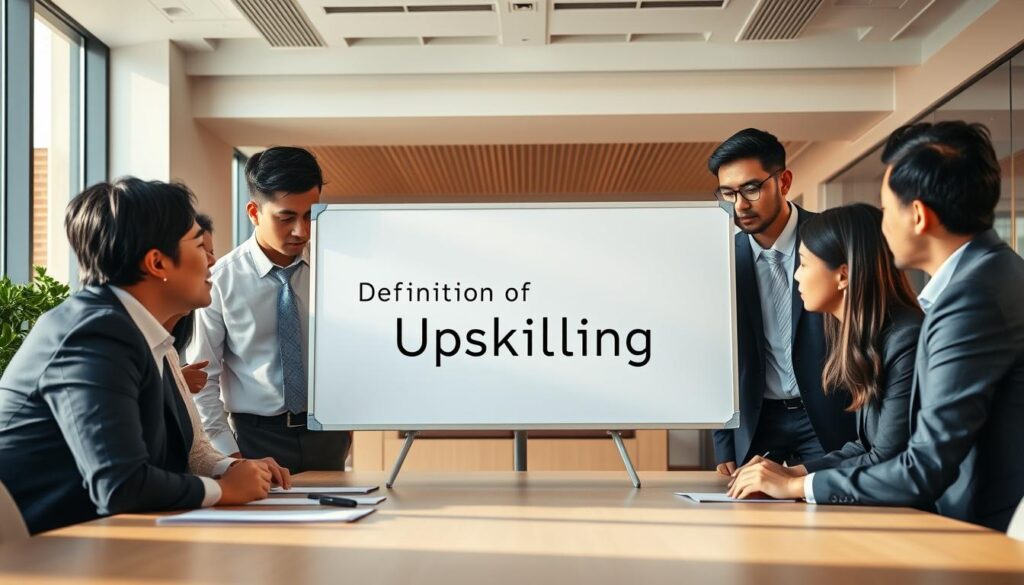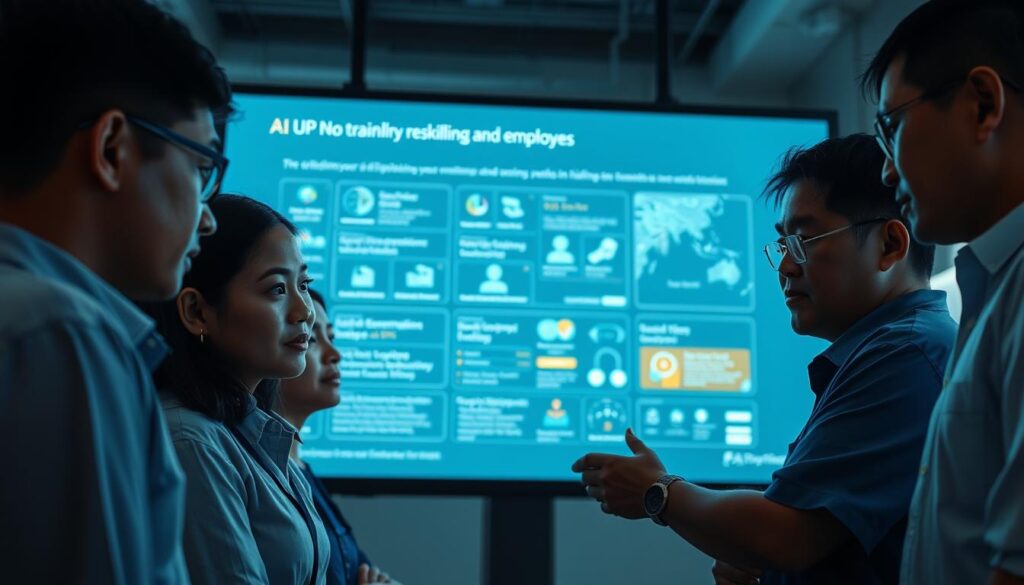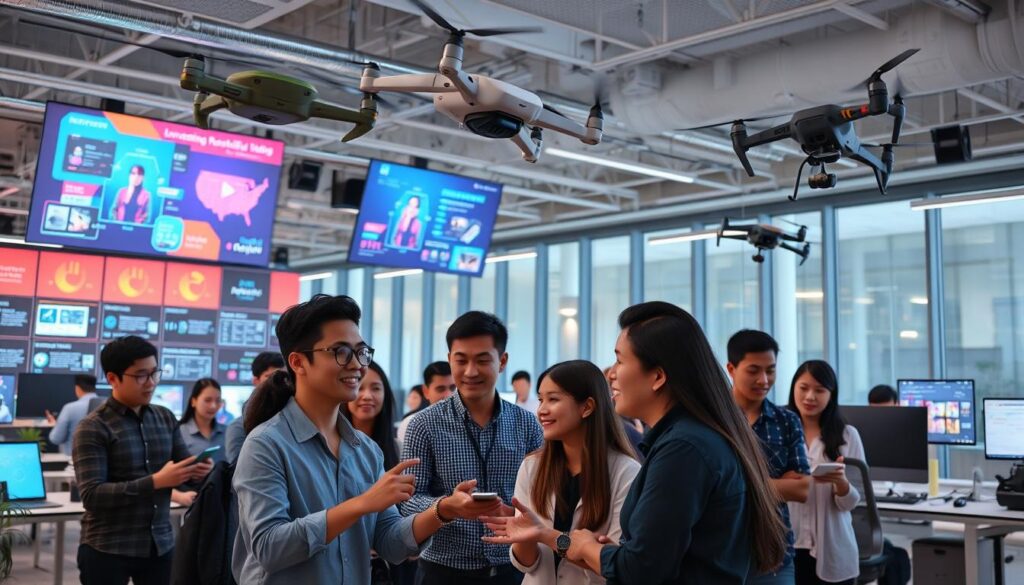Artificial intelligence is changing the world, and a big question is: Are your employees ready for this new era? In the Philippines and Southeast Asia, it’s crucial to upskill for AI and use smart reskilling strategies. With up to 14% of jobs at risk from automation in 15 years, companies must focus on training and change management.
This article will show how businesses can make upskilling and reskilling work. It’s about helping teams adapt and do well in a changing work world.
Key Takeaways
- Understanding the importance of workforce development in the AI era.
- Defining upskilling and its benefits for both employees and organizations.
- Identifying reskilling as a vital strategy for career transitions.
- Exploring AI’s role in enhancing employee training and development.
- Implementing effective strategies for upskilling in the workplace.
- Recognizing common challenges faced during upskilling and reskilling initiatives.
Understanding the Importance of Upskilling and Reskilling
Businesses are changing fast because of AI and automation. Upskilling and reskilling are now key. Companies that keep their employees learning are more flexible and ready for new challenges.
Workers who learn new skills are happier and stay longer. This makes the whole team more relevant and valuable.
Upskilling and reskilling help companies match their team’s skills with what the industry needs. This makes work exciting and encourages new ideas. Studies show that companies that invest in their people do better at keeping and attracting talent.
These efforts make employees feel important and more likely to help the company succeed.
What Is Upskilling?
Upskilling means improving the skills of employees to do their jobs better. It’s key in today’s fast-changing work world. Companies need to keep up with new tech and market changes. Upskilling helps keep the workforce ready for new challenges.
Benefits of Upskilling for Employees
Upskilling offers many benefits for employees. Some of the main advantages are:
- Increased job satisfaction: Learning new skills makes employees happier and more engaged.
- New career opportunities: Advanced skills can lead to promotions and new roles.
- Higher earning potential: Skilled employees often earn more, as they bring more value to their employers.
How Upskilling Impacts Business Performance
Upskilling has a big impact on business success. Companies that invest in employee growth see many benefits, including:
- Improved efficiency: Skilled workers can do tasks faster, saving time.
- Higher productivity: A knowledgeable team can achieve more, helping the company grow.
- Reduced turnover rates: A culture of learning keeps employees loyal, reducing turnover.
By focusing on skill development, companies can build a loyal team. This leads to success and a competitive edge.

| Upskilling Benefits | Organizational Impact |
|---|---|
| Increased job satisfaction | Retention of top talent |
| New career opportunities | Improved employee morale |
| Higher earning potential | Increased company profitability |
What Is Reskilling?
Reskilling is key in today’s fast-changing job world. It means training workers to get new skills for different jobs. This helps them keep up with industry changes. With new tech coming in, it’s vital for keeping a stable workforce.
As industries grow and change, knowing how important reskilling is becomes crucial. It’s important for both businesses and workers.
Transitioning Employees: Why Reskilling Matters
As tech changes jobs, reskilling is key for workers to stay relevant. Companies that reskill their teams can adapt to new needs. This makes the workplace strong and helps employees grow, not just stay the same.
Reskilling is urgent because many jobs will change soon. It’s vital for keeping a career going strong.
Reskilling vs. Upskilling: Key Differences Explained
Reskilling and upskilling both aim to improve employee skills. But they do it in different ways. Reskilling prepares workers for new roles, while upskilling makes them better at what they do now.
Knowing the difference helps companies create better training plans. This meets the needs of their workers in different ways.
| Feature | Reskilling | Upskilling |
|---|---|---|
| Purpose | Training for a new role | Enhancing existing skills |
| Focus | Job transition | Professional growth |
| Examples | Learning data analysis to move from marketing to tech | Taking advanced courses in digital marketing |
| Target Audience | Employees in declining roles | Employees seeking promotion |
AI’s Role in Upskilling and Reskilling
Artificial Intelligence has changed how we train employees. It’s now key for upskilling and reskilling. AI goes beyond just automating tasks. It makes learning better, helping companies fix skill gaps early on.
Leveraging AI Technologies for Employee Development
AI helps create training plans that fit each person’s needs. It looks at data to find out what skills are needed. This way, employees get training that’s just for them.
AI systems can change what they offer on the fly. This keeps learning fresh and effective.
Identifying Skills Gaps with Artificial Intelligence
Doing a thorough skills gap analysis is crucial for any business. AI makes this easier by checking what skills employees have now. It then matches those with what jobs will need in the future.
This helps companies focus their training efforts. It’s good for both the employees and the company.

| AI Applications | Benefits |
|---|---|
| Personalized Learning Paths | Enhances engagement and learning outcomes by catering to individual skill levels. |
| Real-Time Skill Assessment | Enables timely interventions to address skill gaps effectively. |
| Predictive Analytics | Forecasts future skill requirements, guiding training efforts. |
| Content Adaptation | Modifies learning materials based on user performance and preferences. |
Strategies for Effective Upskilling for AI
Upskilling is key for companies to succeed in the AI age. Tailoring training to each employee boosts skills and work efficiency.
Personalized Learning Paths
Personalized learning creates unique learning paths for each employee. It matches their goals with the company’s aims. This approach keeps employees engaged and happy.
When employees feel invested in their growth, they learn and apply new skills better.
Adaptive Learning Platforms
Adaptive learning tech changes as employees progress. It adjusts based on how users interact with it. This makes learning more effective and prepares employees for role changes.
Innovative Reskilling Strategies for the AI Workplace
As work changes with AI, companies need new ways to train their teams. Creating a culture of learning helps employees grow and succeed. This way, they can help the company reach its goals.
Creating a Culture of Continuous Learning
Building a learning culture means making learning part of every day. It’s about having a mindset that says you can always get better. By offering training, companies help their staff grow and contribute more.
Sharing knowledge is key. This can be through mentorship or team projects. It helps everyone learn and work together better.
Encouraging Employee Engagement in Reskilling Programs
Getting employees to join in on training is important. Personal rewards and recognition can really help. Things like games or chances to move up can make a big difference.
When employees see how their learning helps the company, they’re more likely to get involved. This makes everyone’s efforts worthwhile.

10 Ways to Leverage AI for Upskilling and Reskilling
Organizations looking to boost employee skills can use AI in many ways. These technologies help make training better. Here are ten key ways to use AI for training at work:
- Personalized Learning: Use AI to make learning fit each employee’s needs. This makes skills training more effective.
- Skill Assessment: AI tools can check how skilled employees are. They help find what training is needed.
- Smart Content Delivery: AI picks out learning content that fits what employees like. This makes them more engaged.
- Real-time Feedback: AI gives quick feedback. This helps employees see how they’re doing and what they need to work on.
- Predictive Analytics: AI looks at data to guess what training will be needed next. It prepares employees for changes in the industry.
- Chatbots for Support: AI chatbots can answer questions about training anytime. This keeps learning going all the time.
- Gamification: AI makes learning fun with game-like elements. This boosts motivation.
- Collaborative Learning: AI helps create a space for employees to learn from each other. It connects them for sharing and learning together.
- Content Creation: AI can make training materials automatically. This keeps the content up to date.
- Ongoing Monitoring: AI tracks how well employees are learning. It gives insights into how they’re doing.
| AI Strategy | Description | Benefits |
|---|---|---|
| Personalized Learning | Customization of training material based on individual needs. | Improved engagement and retention of information. |
| Skill Assessment | AI evaluates current skill levels accurately. | Identifies specific training needs effectively. |
| Real-time Feedback | Immediate insights on performance and areas for growth. | Accelerates the learning process and boosts confidence. |
Implementing Training & Change Management for Workforce Transformation
Workforce transformation in the AI era needs good training and change management. Companies must set clear goals for employee growth that match business aims. A solid training plan, based on change management, helps employees adjust to new tech and methods.
Training should include feedback, mentorship, and clear goals. This mix helps employees feel secure and involved in changes.
In the Philippines, companies that train well and manage change well do better. They see better employee success and performance. This shows how important it is to link training with change management.
| Key Elements | Role in Workforce Transformation |
|---|---|
| Clear Objectives | Align employee goals with business strategies for targeted results |
| Structured Programs | Facilitate smooth transitions when adopting new processes and technologies |
| Continuous Feedback | Support employee confidence and foster ongoing engagement |
| Mentorship Opportunities | Enhance skill development and organizational loyalty |
| Measure Outcomes | Assess program effectiveness and employee adaptation levels |
Using these elements well is key to a transformative workforce. It creates a place for ongoing learning and growth in the AI era.
Examples of Asian Companies Leading in Upskilling Initiatives
Many Asian companies are upgrading their workers’ skills. They offer lessons for others facing the AI future. These examples show new ways to grow employees, proving that investing in skills really pays off.
Case Study 1: A Successful Implementation in the Philippines
In the Philippines, a big telecom company used AI for training. This made their customer service much better. By focusing on the Philippines workforce, the company gave employees the skills they needed. This led to happier customers and better work.
Case Study 2: Transformative Approaches by a Leading Asian Tech Firm
A top Asian tech company made learning a key part of its work. They offered special training to keep up with market changes. Their focus on upskilling shows how to stay ahead in a fast-changing world.
These stories highlight the importance of smart workforce plans. They improve skills and make workers ready for change. For more on leading in the AI age, see this resource.
The Future of Work: Skills Needed in the AI Era
AI is changing the job world fast. Companies need to teach their workers new skills for the future. This helps both the worker and the company stay strong in a changing market.
Identifying Evolving Skills for Emerging Job Roles
AI makes some skills more important than others. Knowing how to use technology is key for most jobs. Solving complex problems creatively is also vital. Being able to adapt to new situations is crucial too.
Preparing Employees for Unforeseen Changes
Companies must help workers get ready for surprises. By encouraging learning, they keep their team up-to-date. Training in new skills helps workers face AI changes head-on. This keeps the company ahead of the game.

| Skill | Description | Importance |
|---|---|---|
| Digital Literacy | Familiarity and proficiency with digital tools and platforms | Essential for almost all jobs in the AI landscape |
| Critical Thinking | Ability to analyze situations and develop creative solutions | Key to addressing complex problems effectively |
| Workplace Adaptability | Flexibility to adjust to new roles, processes, and technologies | Vital for thriving amidst rapid changes and challenges |
Overcoming Challenges in Upskilling and Reskilling
Starting upskilling and reskilling programs can be tough. One big challenge is getting employees to accept change. They might worry about losing their jobs or feel like they’re not valued. It’s important to talk openly about these changes to help everyone grow together.
Addressing Resistance to Change within Organizations
It’s key to beat resistance for any training to work. Employees want to know that learning will make their jobs better. By showing how new skills help in real life, companies can get their teams excited.
Companies that tackle fears and show the good side of AI see big changes. Employees start to see the value in learning and growing.
Managing Employee Expectations and Career Development
It’s vital to set the right expectations with new programs. Employees need to see how learning can lead to career growth. Clear paths to promotions can ease worries and boost interest in training.
Organizations that manage these expectations well see better engagement and results. For more tips on handling resistance, check out strategies for boosting acceptance within the.
| Challenge | Impact on Training | Solution |
|---|---|---|
| Fear of job displacement | Increased resistance to learning | Implement regular communication about organizational goals |
| Lack of clarity in career paths | Low participation in upskilling programs | Establish clear development pathways linked to training |
| Negative perceptions of AI | Resistance to technology adoption | Foster a culture of continuous learning and adaptation |
Conclusion
The world of work is changing fast. In the Philippines and around the world, it’s crucial for companies to focus on upskilling and reskilling. This means teaching employees new skills to stay ahead in a digital world.
By doing this, companies make their workers happier and more ready for the future. This helps them stay competitive in a changing job market.
The benefits of reskilling go beyond just keeping up. It creates a culture of learning and being able to adapt. This lets employees handle new challenges and grab new chances.
Using AI helps find where skills are missing and tailor training. This brings out the best in workers at a key time.
In the end, focusing on upskilling and reskilling is key for companies to do well in the future. By making these efforts, businesses can not only survive but thrive. They’ll have a strong, ready workforce for the challenges of tomorrow.

